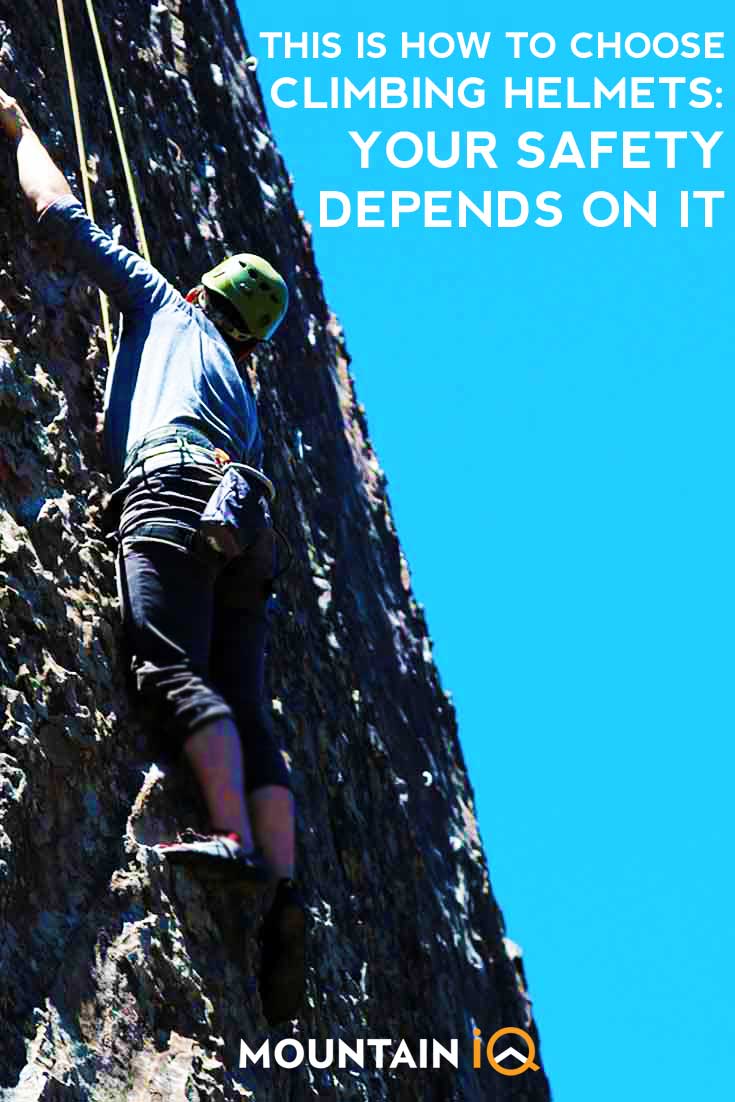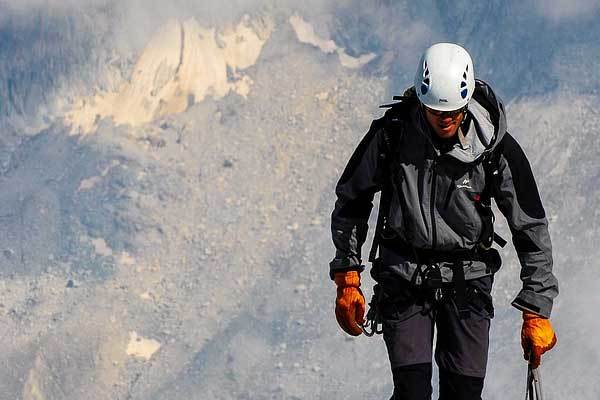Climbing helmets are there to save our lives, yet not get in the way. They do that by staying reasonably solid, comfortable and light. Good buckles also keep them in place, while ventilation holes keep the pesky sweat away. Most helmets are made to provide all these features. Now, how do you choose the right one?
If you're a new climber, go for the classic - Half Dome, it's light, safe and cheap enough. For the pros, it's a toss up between the Black Diamond Vapor and the Petzl Sirocco - both are great, albeit a bit expensive. And, although it's called Vapor, this Black Diamond helmet doesn't evaporate as much sweat.
Best Climbing Helmets (Top Picks)
Best Overall
Best Value
Best Ultra-Light
This article contains affiliate links. If you buy something through the links on this page, we might get a small commission. It will not affect your price but helps keep our site alive!
Top Helmets For Climbing (Detailed Reviews)
I looked at 8 climbing helmets for this article. So here are my top 5 Best Climbing Helmets:
- Black Diamond Vapor - Best Overall
- Black Diamond Half Dome - Best Value
- Petzl Sirocco - Best Ultra-Light
- Black Diamond Vector
- PETZL Meteor
Read our complete buyers guide for climbing helmets.
Best Overall Climbing Helmets
1. Black Diamond Vapor
Insanely expensive, but it's here to save your life. So I'd try it out at least.
Most climbing helmets only cater to heads with a maximum measurement of 61cm, making it hard for those with larger heads to find proper protection.
Black Diamond Vapor is a slick helmet that can cater to up to 63cm.
This helmet is very similar to the Black Diamond’s Vector See below), with the advantage of being slightly lighter and with a lower profile shell.
Also inserted between the EPS co-moulded foam there are a series of carbon rods and a sheet of Kevlar.
This reinforcement allows the foam to be slightly thinner, adding optimal strength for minimal weight. The Vapor also has a polycarbonate shell.
Another weight saver is the cutback on an adjustable buckle. Instead, the two straps that come down below your ears are sewn into the chinstrap.
This means you can’t adjust the placement of the position of the straps, so you have to find the perfect fit before rocking up.
Soft padding along the inner front and top of the helmet makes the Vapor comfortable; on the downside, this is prone to soak up sweat and can’t be removed to clean.
Main Features
What we like
What we dislike
Key Takeaway
With a very similar construction to the much-loved Vector, the Black Diamond Vapor is a perfect alternative for the bigger headed climbers.
2. Black Diamond Half Dome - Best Value
Since I first reviewed Half Dome, it not only grew on me (not literally), but became one of the most popular cheaper climbing helmets of all time. Let's see why.
Although a bit heavy on the head, it's super light on your wallet - at more than half the price cheaper than most other helmets offering similar durability and comfort, Black Diamond Half Dome is the best value helmet.
The Half Dome has been a staple for climbers for ages, but it now boasts an updated design: the new model has more ventilation, more adjustability and a slightly lower profile.
The interior foam lining cushions the head in the front and from above, while the harness system holds the helmet firmly in place. Basically, it now fits better around the head.
The adjustability has a wide enough range that even small heads can wear the large helmets, which makes it useful for groups sharing one helmet.
The hard plastic shell has proven to be far more durable than most helmets, although it also adds extra weight.
Main Features
What we like
What we dislike
Key Takeaway
The Black Diamond Half Dome helmet is great for groups, guides and those who are on a budget, but it is not nearly as light or comfortable as other higher-end helmets.
3. Petzl Sirocco - Best Ultra-Light Helmet
This insanely lightweight helmet is still capable of responding to climbers need for protection and comfort, making it one of the best-rated helmets.
At 170g, the Petzl Sirocco is almost half the weight of the average helmet. It takes a notable amount of strain off the wearer which makes it extremely comfortable.
Also adding to the comfort, the deeper shape of the helmet is found to be more fitting than shallower models.
The EPP foam and EPS plate combine to provide protection over the top of the head against fallings rocks while also maintaining comfort against the head.
Tied in with the hard-plastic exterior, the Petzl Sirocco is also extremely durable. And this is at no cost to its ventilation – the Sirocco’s large ventilation holes keep the helmet airy and the wearer’s head cool.
Main Features
What we like
What we dislike
Key Takeaway
The Petzl Sirocco is by far the lightest and one of the most comfortable and enjoyable climbing helmets to use.
4. Black Diamond Vector - Lightweight & Comfortable
The Black Diamond Vector is a light helmet designed for long routes, alpine climbs and weight-sensitive missions. It is made to feel like the helmet is barely there, making it the most comfortable climbing helmet.
The helmet is made of geometric, co-moulded, lightweight EPS foam with a thin polycarbonate shell. This provides full-coverage protection while keeping light and comfortable; you can even bang it multiple times before you will see any dents.
A webbing harness and plastic adjustment band allow a wide range of adjustment, creating a snug fit with minimal slippage.
With more than enough ventilation ports, it is so cooling and lightweight that you could forget about it.
This is great for the hotter days.
And if you’re still climbing when the sun sets, the Vector’s dependable in-mould headlamp clips ensure that your headlamp won’t fall off.
Main Features
What we like
What we dislike
Key Takeaway
It’s so comfortable, you might forget your are wearing the Black Diamond Vector, plus the ventilation makes it great for the warmer climbing days.
5. PETZL Meteor
The PETZL Meteor is a perfectly good helmet. Very light and a lot more comfortable than the Half Dome value-helmet . It's a medium level helmet - so expect a bit of a higher price, yet a lot of wear out of it.
Main Features
What we like
What we dislike
Key Takeway
PETZL Meteor is great for all types of climbing, it's reasonably light, comfortable and comes with a medium-budget price tag.
Climbing Helmet - Buyer’s Guide (Key Features)
A climbing helmet’s purpose is to protect the most fragile and important part of your body – your head. With falling rocks and dizzy heights, safer is always better. Therefore, protection is what you ultimately want from a helmet.
With modern designs, however, we also have the luxury of comfort, lightness and other attributes, making the definition of a good helmet exceed only protection. Use this guide to help you find the best helmet.
Helmet Type
There are two main helmet types: hardshell helmets and shelled foam helmets. Hardshell helmets (a.k.a suspension helmets or hybrid helmets) have a thin foam liner and an extra-hard outer shell – usually ABS plastic – with a strap suspension system.
They tend to have a lower price and brilliant durability.
Shelled foam helmets have a thicker layer of polystyrene or polypropylene foam underneath a thin polycarbonate exterior. These helmets absorb impact forces. They are usually lighter and well ventilated.
Helmet Fit
Because the feel of a helmet cannot only be deciphered by its measurement as every head shape are personal, the best way to get a good fit is the old-fashioned way – go into a store and try several different models on.
Begin by placing the helmet onto your head with the front rim straight across your forehead, leaving the chin strap unbuckled. Shake your head from side to side and tilt your head back. A good fitting helmet will remain in place.
Next, close the chin strap. The front and back of the straps should form a “Y” around each of your ears, and there should be no slack.
Lastly, play around with the adjustment system - where the headband can be tightened using a wheel or ‘click-strip’ at the back – and see how it feels.
Keep in mind that if you intend to winter climb, you should make sure your helmet still fits nicely over a beanie as well as a bare head.
Intended Use & Weather Conditions
The activity and climate you wish to venture through should influence your choice of helmet.
If you’re planning to haul a lot of gear around for long periods of time, a shelled foam helmet with low weight and good ventilation is ideal.
For warm weather, opt for a shelled foam model with tons of vents. As for ice climbing, a shelled foam helmet is still suitable, but you won’t need much cooling and you’d want to avoid letting any rain or snow on you - so choose a helmet with less ventilation.
Because you can take your helmet off while waiting your turn to climb or belay on cool weathered, single-pitch sport climbs, you can prioritize durability of a helmet over comfort.
And lastly, for indoor climbing, a cool, lightweight shelled foam helmet is the most logical choice as there are no rockfalls.
Lifespan & Durability
This isn’t so much a buyer’s tip as it is an owner’s tip.
Give up your helmet the moment it is cracked, dented or damaged; even if there are no visible dings, you should get it checked out if you experience any intense impacts.
Make sure to check before any climb that your outer shell is free of major dents, the buckles and hardware are looking in order, the webbing is free from frays and tears and the foam casing is secure.
The helmet is there to protect you, and any damage can reduce its ability to do so.
Even it is never impacted, the sun’s UV rays slowly degrade materials, so it is advisable to retire a helmet within 10 years of use.
Continue browsing
See more outdoor equipment reviews and our detailed climbing gear guide. Or check out these reviews:







